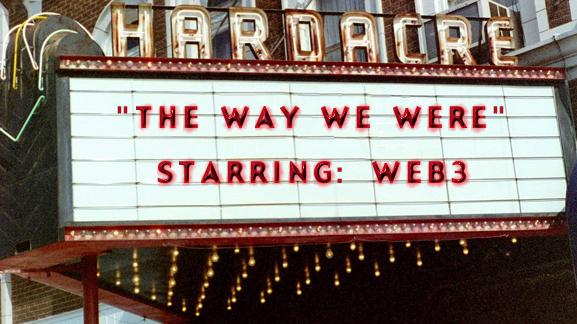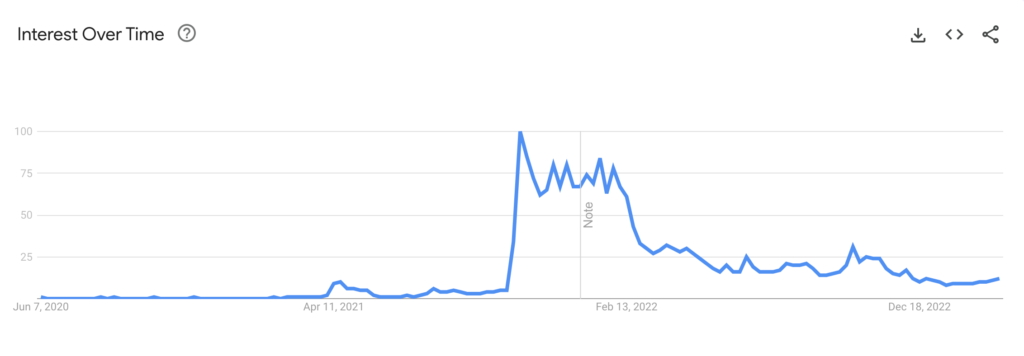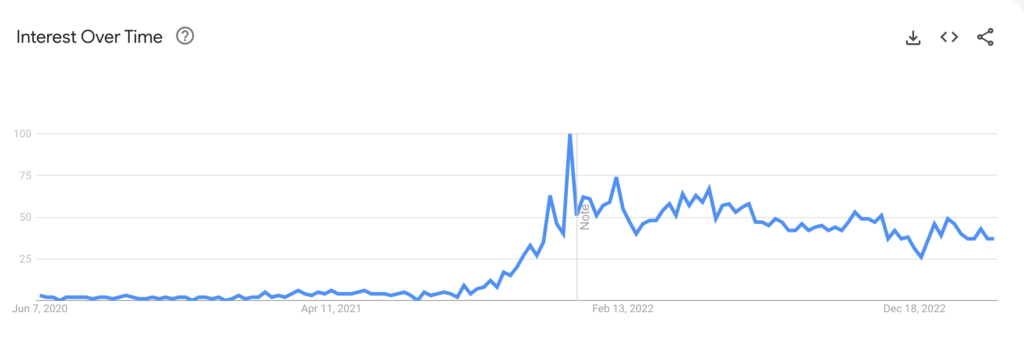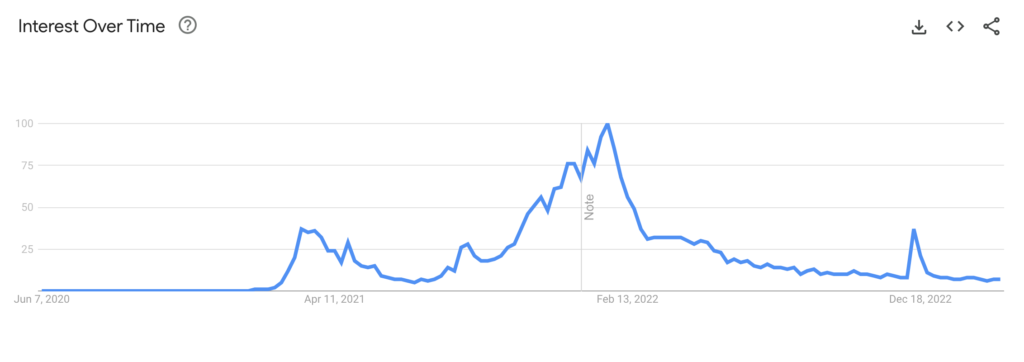
Whatever happened to Web3?
Not long ago, every conference was stuffed with speakers pontificating about NFTs, tokenized economies, and digital wallets. We were promised that
- Web3 is ownership.
- Web3 is freedom.
- Decentralization is the future.
In 2022, Web3 was the dominant topic at the SXSW annual gathering of thought leaders. In 2023, there was barely a mention. When was the last time you used a Web3 function? That’s what I thought.
The rapid disinterest in Web3 is reflected in these Google Trend charts:
NFTs

Web3

Metaverse

We can’t overlook the fact that millions of dollars were invested in these ideas and those investments aren’t going to fade into the night. Will there be a time for Web3? Should marketers still pay attention?
I think so, and today I’ll tell you why.
First let’s look at the challenges facing Web3 development and adoption (at least from my point of view). The following points are GENERALIZATIONS. There are exceptions, of course, so don’t beat me up.
1. Disconnected from business value
Let’s start with the fact that too much focus has been on the sizzle without the steak.
An example. My biggest Web3 annoyance has been POAPs (Proof of Attendance Protocol). This is a simple NFT that is generally a memento from an event. A symbol that you attended something.
In my own community, every time we had an event, somebody was sure to suggest that I create a POAP. The conversation would go like this:
Web3 fan: “This event was great. You should create a POAP.”
Me: “Why?”
“Because we can.”
“But why?”
“Because we should.”
“But why?”
“It would be a nice memory.”
“But it takes work to mint this, and then it sits on a server somewhere burning energy forever. I don’t wanna.”
To me, a POAP is like the cheap pen or sticker you pick up at a trade show, and then you throw it out when you clean out your desk. Except you can’t throw out a POAP.
My point is, that many Web3 ideas are irrational products disconnected from real business cases. Too often, it is cool technology in search of a problem.
2. It’s not user-friendly
I was early to dabble in NFTs because I wanted to experiment and experience what it was all about. I set up a digital wallet, figured out what this eth “gas” was all about, and finally put it all together over two days to actually make a purchase. It was a pain in the ass. Still is.
It has been difficult to “on-board” to Web3, which has depressed consumer adoption.
3. Disconnected from the real world
The breakthrough for the success of the “Web2” internet was the user interface.
If you wanted to save a file, you dragged it to a “folder.”
If you wanted to get rid of a file, you put it in an icon of a trash can.
Every Web2 action was tethered to something you could understand from the real world.
Web3 introduced us to altcoins, defi, degens, hodlers, and other concepts that don’t intersect the real world. In a way, that’s what made it fun for the early adopters. Speaking this cryptographic language made you one of the cool kids and kept others out. But that’s also why Web3 has not been widely adopted.
4. Tarnished reputation
Let’s say I was selling a new sports car. We’ll call it the Mark500. It’s a visionary, futuristic vehicle with a retro vibe, so the most passionate automotive fans rushed to buy one. This created scarcity, and the value of my car soared as favorable press coverage documented that the Mark500 was a great investment!
Oh happy day! Mark is getting rich. I can buy a Taylor Swift ticket!

But there’s one little problem. Everybody can copy my car. I have no meaningful intellectual property to protect my product. Thousands of low-quality Mark500 rip-offs enter the market. It’s confusing to know which car is real.
And then owners discover a big problem. The brakes on the Mark500 don’t work. Every day there seems to be another story of the Mark500 crashing into a tree or driving off a cliff. At first, the early Mark500 owners deny the problems. They are irrationally in love with the technology and want to protect their investments.
But soon, it’s undeniable. The press is reporting brake failures everywhere. Even after I repair my product, there is so much negative publicity that my brand will never fully recover.
The parable of the Mark500 is a story about NFTs. There was so much corruption, so many “rug pulls” and broken promises that most people could not trust the NFT “brand” any more. Sure, a few people held on to their Mark500, hoping for a turnaround. But the general public has moved on.
5. It’s not really decentralized
One of the things I could never understand about Web3 is why people were so in love with “decentralization.” Communities would become democratized and decisions would be made by shareholders, based on how many NFTs or tokens were held. That is almost always a lousy way to make decisions.
Decentralization meant a shift toward a more personalized internet, where data is controlled and owned by the individual. It also meant that owning the rights to your data and owning the rights to a community or product meant that everyone had a say, and everyone could be properly compensated for their time and data.
In a decentralized organization, the shareholders rule.
Occasionally, a democratic process is a good way to make decisions, like an election. But it is usually a terrible way to make most business decisions. That’s a story for another day, but suffice to say that touting “decentralization” as a goal is not really a business advantage in many cases when you need speed, expertise, and decisiveness to win the day.
We may not be happy that companies own our data, but most people are resigned to that reality in exchange for a personalized and free web experience. “Data ownership” is simply not a burning problem for the general population.
Further, as reality played out, it turns out that these Web3 platforms weren’t really decentralized at all. Jack Dorsey famously said:
You don’t own web3. The VCs and their LPs (limited partners) do. It will never escape their incentives. It’s ultimately a centralized entity with a different label.
If you’ve followed this blog for a while, you know that in 2021 I launched a creator cryptocurrency through a platform called Rally. It was a way for people to own a “share” of me. But in the end, Rally was just another VC investment that made stupid decisions and ignored its stakeholders. You can read the story of the rise and fall of my crypto token here.
And yet …
There are aspects of Web3 that I loved. My crypto token helped me build a wonderful, caring RISE community. I could use the token to thank people and reward loyalty. It opened up new business models for monetization. Looking past the silliness of POAPs, NFTs represent a proof of ownership and authenticity, an elegant new way to create contracts, enable new business models, and reward loyalty.
There is SO MUCH POTENTIAL.
But clearly, problems have to be solved.
Web3 must be focused on true business value and grounded best practices tethered to reality. Obstacles to mass adoption like digital wallets and ridiculous “gas fees” have to go away or at least become invisible in the consumer journey.
And, we’ll probably have to stop using tarnished words like NFT or Web3, just like the doomed Mark500 would have to be reimagined and re-branded to be trusted again.
Now, here is the good news.
It’s happening. These problems are being solved. There is an undercurrent of Web3 successes bubbling up in mainstream businesses.
One example of this is an idea called “Open Loyalty” being pioneered by brainiacs like Mathew Sweezey. Mathew was a co-founder of the Salesforce Web3 Studio and is now on his own, helping brands apply Web3 in a rational way. Web3 is being reimagined!
To learn what Open Loyalty is all about and glimpse how Web3 is evolving into a truly customer-friendly experience, please listen to what Mathew has to say in the latest episode of The Marketing Companion podcast. I predict you’ll agree with me — Web3 is not over yet. It may be just beginning.
All you have to do is click here to hear the show:
Click here to listen to episode 274
 Mark Schaefer is the executive director of Schaefer Marketing Solutions. He is the author of some of the world’s bestselling marketing books and is an acclaimed keynote speaker, college educator, and business consultant. The Marketing Companion podcast is among the top business podcasts in the world. Contact Mark to have him speak at your company event or conference soon.
Mark Schaefer is the executive director of Schaefer Marketing Solutions. He is the author of some of the world’s bestselling marketing books and is an acclaimed keynote speaker, college educator, and business consultant. The Marketing Companion podcast is among the top business podcasts in the world. Contact Mark to have him speak at your company event or conference soon.
Follow Mark on Twitter, LinkedIn, YouTube, and Instagram.


